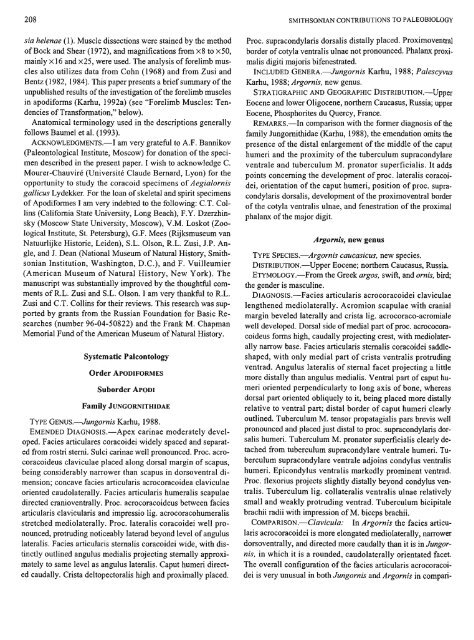PDF (Lo-Res) - Smithsonian Institution Libraries
PDF (Lo-Res) - Smithsonian Institution Libraries
PDF (Lo-Res) - Smithsonian Institution Libraries
You also want an ePaper? Increase the reach of your titles
YUMPU automatically turns print PDFs into web optimized ePapers that Google loves.
208 SMITHSONIAN CONTRIBUTIONS TO PALEOBIOLOGY<br />
sia helenae (1). Muscle dissections were stained by the method<br />
of Bock and Shear (1972), and magnifications from x8 to x50,<br />
mainly x 16 and x25, were used. The analysis of forelimb muscles<br />
also utilizes data from Cohn (1968) and from Zusi and<br />
Bentz (1982, 1984). This paper presents a brief summary of the<br />
unpublished results of the investigation of the forelimb muscles<br />
in apodiforms (Karhu, 1992a) (see "Forelimb Muscles: Tendencies<br />
of Transformation," below).<br />
Anatomical terminology used in the descriptions generally<br />
follows Baumel et al. (1993).<br />
ACKNOWLEDGMENTS.—I am very grateful to A.F. Bannikov<br />
(Paleontological Institute, Moscow) for donation of the specimen<br />
described in the present paper. I wish to acknowledge C.<br />
Mourer-Chauvire (Universite Claude Bernard, Lyon) for the<br />
opportunity to study the coracoid specimens of Aegialornis<br />
gallicus Lydekker. For the loan of skeletal and spirit specimens<br />
of Apodiformes I am very indebted to the following: CT. Collins<br />
(California State University, <strong>Lo</strong>ng Beach), F.Y. Dzerzhinsky<br />
(Moscow State University, Moscow), V.M. <strong>Lo</strong>skot (Zoological<br />
Institute, St. Petersburg), G.F. Mees (Rijksmuseum van<br />
Natuurlijke Historie, Leiden), S.L. Olson, R.L. Zusi, J.P. Angle,<br />
and J. Dean (National Museum of Natural History, <strong>Smithsonian</strong><br />
<strong>Institution</strong>, Washington, D.C), and F. Vuilleumier<br />
(American Museum of Natural History, New York). The<br />
manuscript was substantially improved by the thoughtful comments<br />
of R.L. Zusi and S.L. Olson. I am very thankful to R.L.<br />
Zusi and CT. Collins for their reviews. This research was supported<br />
by grants from the Russian Foundation for Basic <strong>Res</strong>earches<br />
(number 96-04-50822) and the Frank M. Chapman<br />
Memorial Fund of the American Museum of Natural History.<br />
Systematic Paleontology<br />
Order APODIFORMES<br />
Suborder APODI<br />
Family JUNGORNITHIDAE<br />
TYPE GENUS.—Jungornis Karhu, 1988.<br />
EMENDED DIAGNOSIS.—Apex carinae moderately developed.<br />
Facies articulares coracoidei widely spaced and separated<br />
from rostri sterni. Sulci carinae well pronounced. Proc. acrocoracoideus<br />
claviculae placed along dorsal margin of scapus,<br />
being considerably narrower than scapus in dorsoventral dimension;<br />
concave facies articularis acrocoracoidea claviculae<br />
oriented caudolaterally. Facies articularis humeralis scapulae<br />
directed cranioventrally. Proc. acrocoracoideus between facies<br />
articularis clavicularis and impressio lig. acrocoracohumeralis<br />
stretched mediolaterally. Proc. lateralis coracoidei well pronounced,<br />
protruding noticeably laterad beyond level of angulus<br />
lateralis. Facies articularis sternalis coracoidei wide, with distinctly<br />
outlined angulus medialis projecting sternally approximately<br />
to same level as angulus lateralis. Caput humeri directed<br />
caudally. Crista deltopectoralis high and proximally placed.<br />
Proc. supracondylaris dorsalis distally placed. Proximoventral<br />
border of cotyla ventralis ulnae not pronounced. Phalanx proximalis<br />
digiti majoris bifenestrated.<br />
INCLUDED GENERA.—Jungornis Karhu, 1988; Palescyvus<br />
Karhu, 1988; Argornis, new genus.<br />
STRATIGRAPHIC AND GEOGRAPHIC DISTRIBUTION.—Upper<br />
Eocene and lower Oligocene, northern Caucasus, Russia; upper<br />
Eocene, Phosphorites du Quercy, France.<br />
REMARKS.—In comparison with the former diagnosis of the<br />
family Jungornithidae (Karhu, 1988), the emendation omits the<br />
presence of the distal enlargement of the middle of the caput<br />
humeri and the proximity of the tuberculum supracondylare<br />
ventrale and tuberculum M. pronator superficialis. It adds<br />
points concerning the development of proc. lateralis coracoidei,<br />
orientation of the caput humeri, position of proc. supracondylaris<br />
dorsalis, development of the proximoventral border<br />
of the cotyla ventralis ulnae, and fenestration of the proximal<br />
phalanx of the major digit.<br />
Argornis, new genus<br />
TYPE SPECIES.—Argornis caucasicus, new species.<br />
DISTRIBUTION.—Upper Eocene; northern Caucasus, Russia.<br />
ETYMOLOGY.—From the Greek argos, swift, and ornis, bird;<br />
the gender is masculine.<br />
DIAGNOSIS.—Facies articularis acrocoracoidei claviculae<br />
lengthened mediolaterally. Acromion scapulae with cranial<br />
margin beveled laterally and crista lig. acrocoraco-acromiale<br />
well developed. Dorsal side of medial part of proc. acrococoracoideus<br />
forms high, caudally projecting crest, with mediolaterally<br />
narrow base. Facies articularis sternalis coracoidei saddleshaped,<br />
with only medial part of crista ventralis protruding<br />
ventrad. Angulus lateralis of sternal facet projecting a little<br />
more distally than angulus medialis. Ventral part of caput humeri<br />
oriented perpendicularly to long axis of bone, whereas<br />
dorsal part oriented obliquely to it, being placed more distally<br />
relative to ventral part; distal border of caput humeri clearly<br />
outlined. Tuberculum M. tensor propatagialis pars brevis well<br />
pronounced and placed just distal to proc. supracondylaris dorsalis<br />
humeri. Tuberculum M. pronator superficialis clearly detached<br />
from tuberculum supracondylare ventrale humeri. Tuberculum<br />
supracondylare ventrale adjoins condylus ventralis<br />
humeri. Epicondylus ventralis markedly prominent ventrad.<br />
Proc. flexorius projects slightly distally beyond condylus ventralis.<br />
Tuberculum lig. collateralis ventralis ulnae relatively<br />
small and weakly protruding ventrad. Tuberculum bicipitale<br />
brachii radii with impression of M. biceps brachii.<br />
COMPARISON.—Clavicula: In Argornis the facies articularis<br />
acrocoracoidei is more elongated mediolaterally, narrower<br />
dorsoventrally, and directed more caudally than it is in Jungornis,<br />
in which it is a rounded, caudolaterally orientated facet.<br />
The overall configuration of the facies articularis acrocoracoidei<br />
is very unusual in both Jungornis and Argornis in compari-

















